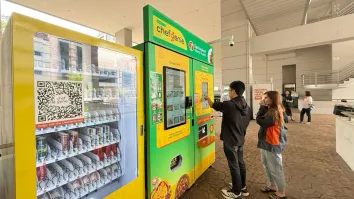Why the recent deal with KFC, Taco Bell, and Grubhub is so appealing for the entire food delivery industry
Did you know that mobile food ordering has now eclipsed ordering via the telephone in most markets? Additionally, the reach of restaurant categories that weren’t typical delivery options has been extended; historically Pizza, Chinese and perhaps Italian sandwiches were common, but much of what you will find in the mobile sphere nowadays wasn’t available for delivery. In the mid-90s, McDonald’s offered bike delivery in China, but that was certainly an early move in the Quick Service Restaurant (QSR) space to explore the field. But the playing field has changed and every food outlet, ranging from a well operated QSR, fast casual to a luxury, Michelin-starred restaurant has the potential to see growth “in the bag” as bags leave to cater to those who ordered to go/takeaway for delivery.
The rise in mobile ordering stems from both convenience and efficiency being key fundamental drivers of change. For a customer, ordering on one’s mobile means that he or she has complete control over their order. Additionally, selections that historically had to be painfully described regarding preferences, dietary needs, and cooking styles can be entered and clarified in seconds. Overall, order accuracy is increased and orders can be funneled straight to in-restaurant tablets or kitchen management systems, bypassing external complexities. With some delivery companies, they make it easy to track incoming orders as well as reference previous orders. Finally, they also have a multitude of payment options available to consumers, allowing a simpler, easier payment method than dictating a card over the phone, a delivery driver manually capturing a consumers’ card number, or a driver receiving a cash payment not having change.
What can we expect to see in 2018:
1. Increased Control Over Your Order Environment
Whether it is time-slot selections for specific delivery periods to make sure you receive your food exactly when you want it, temperature or spice level control, and delivery instructions ranging from simple meet & greets to catering set ups, control is poised to increase. Artificial intelligence (AI) will enter this space as an adjunct helper, allowing one to not only benefit from previous orders and preference data, but also from scenario based questions. “I am having 6 guests over and need a complete Japanese meal, what do you recommend?” Such queries are logical starting points towards enhancing recommendation engines, simplifying even item selection and allowing you to tweak the results.
2. Order Accuracy Will Increase
Some mobile implementations still have room for error. Notes are often disregarded by busy restaurants, so prep instructions will migrate towards those restaurants who have existing kitchen management systems. No more missed instructions, as all major players are exploring this challenge.
Order and issue rectification is as simple as tapping a few buttons and perhaps snapping a photo. As the platforms compete, they will insure that food arrives on-time, at the right temperature and according to a customers’ specifications.
3. Order Tracking
Have you ever called a restaurant to ask where your food is?
Waiting is a challenging prospect when it comes to food. Setting expectations is important, but keeping them is essential. Between kitchen estimated cook times and known traffic conditions, algorithms will continue to enhance the prediction-versus-actual delivery equation.
4. Business Ordering Friendly
It is tough to manage paper receipts and most know they are essential for certain tax purposes business order reimbursement. Growth in this market proves that the delivery ecosystem has an added benefit of record keeping and the ability to find and categorize business receipts easily. Some mobile delivery platforms even allow multiple payment methods, allowing business payment cards to be used in tandem with personal cards.
2018 we should see deals with unexpected partners such as firms like Concur, Quicken, and others to provide seamless integration and categorization of electronic order documentation.
5. Mobile Food Ordering Industry Growth
Finally, mobile ordering has taken hold in a positive way. Busy individuals are able to order food in new and innovative ways. From Grubhub, Postmates, UberEats, DoorDash, Waiter.com to individual applications such as Panera Bread’s endeavors and Domino’s Pizza’s wildly successful platform, consumers benefit through increased adoption. Voice assistants, such as Amazon’s Alexa and Google, are seeing integrations and more is yet to come. Smart refrigerators, such as Samsung’s latest, come preloaded, for example, with the Grubhub app!
YUM! Brands, don’t forget, has many franchisees who subscribe to the overall philosophy to adopt this technology. At a 1:20 (Corporate Owned to Franchisee Owned ratio), YUM! certainly is likely betting that this fast growing technology will allow its’ franchisees to see rapid ROI increases.
5. And, by 2019? Taste & Craving Analysis
Humans still vary in terms of what they like, crave at particular times and meal prompting or meal aversion triggers. Being at the gym may satiate a craving and defer it until later. Seeing a co-worker eating at lunch may trigger a user to peruse delivery options on their mobile. Chinese New Year is nearly here (16 February becomes the year of the Dog. Asian communities across continents and China itself will have some streets filled with the wonderful scents of the holiday.
But the science of taste analytics isn’t new. One’s palate – smell, texture, and taste preferences are truly different and do change. Pairing and situational association are also factors studied intensely by industries such as the snack industry.
2019 should see even more excitement as companies work towards the ultimate solve for optimization enthusiasts – an alert that prompts you what you want to eat, even before you’ve given it any thought! For those who opt-out for essentially letting the ‘Digital AI Chef’ recommend and decide options aimed to please, all of the other efficiencies would still be available. Still, isn’t it nice to be suggested a nice tasty snack or cup of a perfectly suitable tea right when you need it?


























